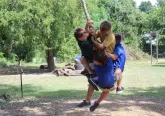OHSAA Competitive Balance Proposal fails again

For the third year in a row Ohio schools have voted down an OHSAA competitive balance proposal that seeks to change how schools are assigned to specific divisions in postseason tournament.
While striking down the proposal keeps the status quo for now, OHSAA Commissioner Dr. Dan Ross indicated that it also puts the possibility of splitting public and private schools into separate tournaments back on the table.
This year’s proposal would have affected how divisions were assigned in the team sports of football, soccer, volleyball, basketball, baseball and softball. Rather than place schools into OHSAA tournament divisions based strictly on male or female enrollment, an adjusted enrollment count would have been used. The adjusted count would have been derived by multiplying a sport specific factor by the number of students in grades 9 through 12 on each specific team roster whose parents reside outside the public school district or the attendance zone of the school, then adding that number to the original enrollment count.
In short, the proposal meant Ohio’s 119 private schools (roughly 90 of which are Catholic) could be forced to compete in higher divisions if their students come from neighboring public school districts.
The competitive balance proposal failed 327 to 308 (51.5 percent to 48.5 percent). Similar competitive balance proposals failed 339 to 301 (53 percent to 47 percent) in 2012 and 332 to 303 (52 percent to 48 percent) in 2011. Approval of this year’s proposed amendment would have been implemented in 2015.
“When this new proposal was placed on the ballot, we said at the time that the vote would come down to the wire, and it certainly did,” Ross said. “It’s disappointing that it did not pass because we believed this formula addressed the main issue to which schools voiced concern: the impact on athletic success by students on a school’s team roster who are from outside that school’s geographic boundary or attendance zone.
While Ross was disappointed, Alter High School Athletic Director Christina Hart had a different take.
“I think we’re very excited,” she said. “I think it’s a good thing for private schools of our size. There’s only 119 private schools in Ohio, so for almost 52 percent of the membership to vote the way they did is sending a message. Certainly what we have is not perfect, but it’s ok for right now, especially compared to the choices we’ve been given three years in a row now.”
Hart shared concerns expressed by other area athletic directors that this proposal’s failure could renew calls to separate private and public schools completely.
“I know that’s exactly what’s going to happen,” Hart said. “We were told when Dr. Ross introduced this new referendum. He said if this does not pass, the public-private split would be put back on the ballot next spring.”
A proposal that called for all OHSAA tournaments to be conducted separately for public schools and private schools was removed from this year’s ballot in late March when it was replaced by the latest competitive balance proposal.
“I believe separation of our tournaments is not the best option,” Ross said. “That being said, I also believe almost 50 percent of our member schools believe some type of change is needed, but no one seems to have the answer for what change would satisfy the most people. One thing seems pretty certain, though: this issue is not going to go away. It’s something in which many, many other states are also struggling to find an answer.”
High school principals had between May 1 and 15 to cast their votes on this and seven other issues. A total of 156 schools failed to vote on the competitive balance proposal. An additional 27 schools voted past the deadline and and four returned invalid ballots.
The complete final voting results are available on the OHSAA website, and the 2013-14 OHSAA Constitution and Bylaws will be posted on the site sometime in late June or early July.
A Review of the Other 2013 OHSAA Referendum Issues
Constitution 5, Governance — Changes the ex-officio member on the OHSAA Board of Directors from the Ohio Interscholastic Athletic Administrators Association (OIAAA) to a representative of the OIAAA rather than the president-elect. Effective date: August 1, 2013.
551 in favor; 85 opposed
Constitution Article 8, Amendments to the Constitution and Bylaws — In the event that a conflict would arise with Ohio state law or proposed legislative action that necessitates an immediate change in the bylaws or constitution, this change permits the Board to authorize an emergency petition for vote of the membership to change or modify a bylaw or article of the constitution. Effective date: August 1, 2013.
561 in favor; 75 opposed
Bylaw 4-3, Enrollment and Attendance — Adds a note preceding Section 3 to clarify enrollment status; amends exception 7 of Bylaw 4-3-1 to note that students who attend STEM schools are also subject to the transfer bylaws, and modifies Bylaw 4-3-2 to make it clear that the bylaw applies only to the application of the semester bylaws within this section and also clarifies that a student is still considered to have transferred whenever his or her enrollment is changed to another high school, even if the student has not been officially withdrawn from the former high school. Effective date: June 1, 2013.
557 in favor; 79 opposed
Bylaw 4-6-3, Residence — Adds language that would permit the Commissioner’s Office to grant eligibility to a student who moves into Ohio with an individual who has had legal custody of the student for more than one year and the parents do not reside in Ohio. The student would not be eligible until ruled so by the Commissioner’s Office. This also adds another exception that addresses an unusual situation in which a United States citizen, who is precluded from obtaining a J-1 visa due to his or her U.S. citizenship, cannot study in the United States for one year when the parents are not U.S. citizens and live outside the United States. This exception would permit just one year of participation in interscholastic athletics. Effective August 1, 2013.
562 opposed; 71 in favor
Bylaw 4-9, Recruiting — This proposal would have permitted open houses to take place in specified facilities other than just the high school campus.
324 opposed; 309 in favor
Bylaw 4-10, Amateur— Modifies the bylaw by permitting students to receive travel expenses to competitions from sponsors that are not connected with their school. Effective date: June 1, 2013.
460 in favor; 171 opposed
Bylaw 4-4-5, Scholarship (7th-8th Grade Issue) — Adds exceptions 1 and 2 to this scholarship bylaw to track the same provisions that are found in the high school scholarship bylaw (waiver for a student who has been withdrawn of removed from school due to accident, illness or family hardship; ability to restore eligibility when an ‘incomplete’ has been received in one or more courses due to calamity days, family tragedy or illness/accident and the ‘incomplete’ is recorded in accordance with board policy). Effective date: August 1, 2013.
347 in favor; 183 opposed
This report complied from the OHSAA press release on the referendum and The Catholic Telegraph staff reports.













